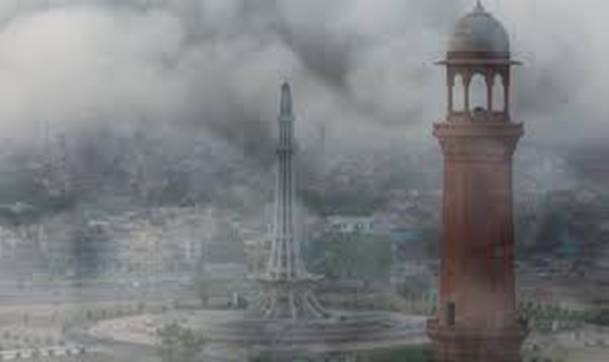|
With the ‘fifth season’ – smog in northern India and Pakistan – catalyzing a major health crisis that is reducing life expectancy in cities like Delhi and Lahore, cross-border conversations on air pollution and cooperation for possible solutions might not be avoidable for too long
Could ‘Climate Diplomacy’ Be the Googly – A Gamechanger for Regional Cooperation?
By Mandira Nayar
Delhi, India

Cricket diplomacy has been bowled out. India will not travel to Pakistan for the Champions Trophy. The International Cricket Council has ruled that the two teams will play each other at a ‘neutral’ ground. With the era of bringing temperatures down by cricket apparently over, can climate diplomacy — specifically conversations on air pollution — deliver a googly to be the gamechanger?
The air quality index or AQI numbers speak for themselves. This November, Multan saw an AQI of over 2000, Lahore 1000, and Delhi over 500 AQI. In India, the average particulate matter or PM, at 2.5 is nearly 11 times higher than the World Health Organization’s acceptable limit. In Pakistan, it is close to 15. Every winter brings with it the season of the gas-chamber. Thick smog brings life to a standstill in northern India and Pakistan.
In Delhi, the government implemented Stage IV of the Graded Response Action Plan for pollution – which includes closing schools, a ban on construction activities, restrictions on non-essential polluting trucks entering the city. Across the border in Lahore, officials declared pollution a ‘calamity’. India leads in fatality.
December saw over 40,000 people treated for respiratory ailments in Lahore. Pakistan declared a health emergency - schools were shut and wearing masks were made mandatory in Lahore .
The UNICEF representative in Pakistan, Abdullah Fadil, urged the government to act. He attributed 12% of deaths in children under-5 in Pakistan to air pollution before the “record-breaking levels of air pollution” this year.
He said it would take time to assess the impact of “this year’s extraordinary smog” but the doubling and tripling of air pollution “will have devastating effects, particularly on children and pregnant women.”’
TOXIC AIR
A July 2024 study by Lancet, a weekly peer-reviewed medical journal, revealed that 11.5% of deaths in Delhi every year are linked to air pollution. A 2021 study by the Indian Council for Medical Research claimed that 1.7 million deaths in India in 2019 were due to the air Indians breathe.

The Air Quality Life Index claims air pollution robbed Pakistanis of 3.9 years of their life on average; Lahoris lose seven years. Studies have linked the exposure to air pollution with low birth weight in babies, dementia and cancer.
The Air Quality Life Index claims air pollution robbed Pakistanis of 3.9 years of their life on average; Lahoris lose seven years. Studies have linked the exposure to air pollution with low birth weight in babies, dementia and cancer. Data shows, however, that smog, dubbed ‘fifth season,’ is not the only foul air. In 2023, Delhi recorded only one good air day throughout the year. An AQI of below 50 is categorized as “good”. In 2024, the AQI never fell below 50 on any day, dispelling the myth that air pollution is a seasonal problem.
Come winter, India and Pakistan blame each other for the toxic air. But there is a growing awareness that the solution has to be collective.
Maryam Nawaz, Chief Minister of Punjab, Pakistan, made a case for “climate diplomacy” while addressing a Diwali function in Lahore in November.
“This is not a political issue, it is a humanitarian one,” she said.
Soon afterwards, speaking at COP29, the Conference of the Parties to the United Nations Framework Convention on Climate Change, in Azerbaijan in November, Naresh Pal Gangwar, India’s Joint Secretary of the Ministry of Environment, Forest, and Climate Change, stressed the transboundary nature of air pollution. He noted that most countries in the region share the Indo-Gangetic Airshed, and stressed the need for collective action to tackle air pollution.
But so far, little has changed on the ground. The relationship between India and Pakistan has remained strained since 2016 after a terror attack on an Army camp in Uri near the Line of Control killing 19 Indian soldiers. Neither side has had a high commissioner stationed in Delhi and Islamabad since 2019 when the Indian Parliament revoked Article 370 of the Constitution, which had given Jammu and Kashmir special status.
Indian external affairs minister S. Jaishankar's visit to Islamabad for the Shanghai Cooperation Organization meeting in October, while limited to a multilateral forum — was a symbolic move forward. There was no conversation for further engagement between the two countries.
But as a health crisis brews, conversations on air pollution and for possible solutions might not be avoidable for too long.
“The wind knows no boundary,’’ said Devindra Sharma, a researcher who specializes in agriculture and economy in Punjab, talking to Sapan News. “We can’t find solutions without talking across the border, especially for Punjab.”
Conversations across the Punjab border are essential, he said, especially as the water, as well as the air is shared.
Air pollution has emerged as a regional crisis – an “invisible killer’’ that is increasingly the top public health concern. Cities across South Asia compete for the most polluted air in the world. The hot spot for the worst air in the world, 37 out of the 40 most polluted cities, are located in the region.
From Kathmandu to Lahore, Delhi to Dhaka, South Asians live under a brown haze. Images released by NASA in November showed that this brown cloud -- that settles across northern India and Pakistan during the winter – is visible from space.
“A unified, science driven approach by the Punjabs can be the answer to the region’s air quality crisis,’’ Dr Jolly Masih, agribusiness scientist at BML Munjal University based in Gurgaon India told Sapan News.
Track 2 dialogues between India and Pakistan space have tried to begin conversations around sticky points like nuclear weapons, military and trade. But focusing on climate change — an issue that is pressing and likely to become more fraught in the future — is relatively new territory.
In November, the UK-based nonprofit Conciliation Resources brought together experts on both sides to focus on climate change at a meeting in Nairobi, where diplomats, experts and journalists recommended knowledge-sharing of best practices. There was an agreement on the need to share information on water and air. So, can smog, especially during winter when crop burning contributes to worsening air quality — provide clarity needed to foster Indo-Pak engagement?
This is a possible area that can be “ring fenced” from politics and a case made for sharing best practices, said TCA Raghavan, former high commissioner to Pakistan talking to Sapan News in Delhi.
Unlike trade or even water that can be viewed through a political lens, air pollution does not have the baggage of earlier confidence-building measures for possible ‘ice breaking’. It also has the advantage of being for greater common good and has not been discussed politically before, unlike water.
With India having chosen to take the mantle of a climate-leader in the region, it could be a conversation worth starting “if you want to give the impression of forward-looking leadership given the demographics,’’ former ambassador Rakesh Sood told Sapan News.
“Air pollution is a subject with positive appeal with youth and the new generation and could be a win-win for both sides,” he adds.
COMMONALITY
India and Pakistan have banded together for a greater cause before. In 2020, facilitated by the United Nations Food and Agriculture Organization, they came together to fight a locust invasion that was destroying their crops on both sides. The mechanism, which requires monitoring on both sides by experts, has now been institutionalized and has survived tensions in the relationship.
A locust can eat its body weight in food. A swarm of locusts – sometimes up to 40 million locusts– can consume food for 35,000 people in a day. This has the potential to destroy crops and impact food security.
A mechanism to control this pest invasion was first initiated in 1939, under India's ministry of agriculture located in Delhi with a substation in Karachi. Locust swarms had destroyed crops from 1926 to 1931 and the need to exchange information on crops was essential. There was locust plague in Iran in 1950, where the egg density reached 1,000 egg/ m2. The FAO–under the newly formed United Nations became involved and later a tripartite collaboration agreement was agreed between Iran, India, and Pakistan.
There is also a mechanism for sharing information about shared rivers, through the Indus Water Treaty which has functioned even during periods of strife.
But there is no shared data on air pollution.
“The similarities in source profiles, geography and policy responses mean that there are clear opportunities for both countries to learn from each other,’’ said Dr Bhargav Krishna, researcher and convenor of Sustainable Futures Collaborative based in India talking to Sapan News.
According to Dr Krishna, Pakistan's policy response to air pollution is a few years behind India. In areas like transport or crop burning, Pakistan can learn what has and hasn't worked in India to tailor a modified approach. For example, Indian farmers currently do not burn Basmati crop residue, unlike their counterparts in Pakistan.
“There is an opportunity for us to learn why that is the case and ensure we don’t deal with the same challenge down the road,” Dr Krishna added.
Other possible areas of cooperation include early warning systems especially with the dust storms that originate in the Middle East, suggested Bharati Chaturvedi, founder of Chintan Environmental Research and Action Group, an India-based environmental NGO talking to Sapan News. Such dust storms reduce visibility to nearly zero and can prove fatal.
Pollution can be fatal too. It also impacts the quality of life — daily. A study by the Harvard T.H Chang School of Public Health in August 2023 revealed that prolonged exposure to outdoor pollution may increase non-lung cancer in older adults.
Closer home, a study by Chintan, a New Delhi-based NGO titled ‘Saaf Saans — Breathing Clean: A Citizen Survey on Air Pollution’, surveyed 500 respondents in Delhi and the National Capital Region to find their awareness about pollution. The study found that 33 percent of residents claimed that they spent extra on doctor fees and medicine. The study conducted between December 2023 and March 2024 revealed that 90 percent of the people were impacted by pollution.
Half the respondents lived in informal settlements, the rest in middle income and high-income settlements. Nearly half, 46% of those living in informal settlements reported spending money on medical expenses, compared to 21% middle class respondents, due to pollution related ailments. The middle class have the luxury of air-purifiers.
Chaturvedi believes sharing research methodology — especially when it comes to measuring the effects on pollution as a diagnostic tool for doctors – will help practitioners from reinventing the wheel.
“There is a need for the exchange of information on technical data,’’ Chaturvedi added.
For India and Pakistan, where the bulk of those exposed to the fine particulate matter live on the margins, such cooperation is especially critical . It can help save lives.
(Mandira Nayar is a journalist with over two decades of extensive reporting experience across South Asia, and was until recently Deputy Chief of Bureau at The Week in Delhi. She earlier worked for The Hindu and The Telegraph. A Charles Wallace scholar, she has been the chronicler of tiny details and people who are footnotes in history. She is a founding member of the South Asia Peace Action Network , Sapan.)
This is a Sapan News syndicated feature |

